
As open-plan living becomes more popular, it’s no surprise that this concept extends to bathrooms. For homeowners looking for a retreat as tranquil as going to a spa, a wetroom-style bathroom is the most suitable option. These types of bathrooms typically feature road-free shower areas and freestanding bathtubs, and the airy design allows for stylish, modern, and luxurious finishes and fixtures. Humid rooms save space and are ideal for people who care in home or have limited mobility. But there are structural and budgetary considerations, and this style is not for everyone. Here’s a guide to wet room design and what you need to know when installing a wet room.

The damp room has a walk-in shower with no or low curb, which can be partially or completely glazing, or has a pony wall to provide some separation and control splashing, and the floor has a slight slope so that water flows to the drain and not the rest of the space.
Designed by Very Red Design, Seattle’s curbless shower features floor tiles that extend to the rest of the bathroom for a consistent, streamlined look. The pony wall provides some isolation and privacy, and the shower glass chute can be opened.
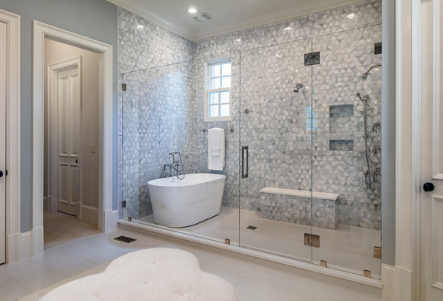
Wet rooms can be equipped with rain shower heads high on walls or ceilings, or wall-mounted hand-held showers. Rain shower heads are especially useful in wet rooms because they shoot downwards and prevent water from entering the rest of the bathroom. There may be a freestanding bathtub in the space, and accessories such as steam showers and benches are also natural additions. The walls are usually tiled from floor to ceiling to make them waterproof.
Some damp rooms have a curbless shower area with or without the typical frameless glass pane separating it from the rest of the space. Placing the shower area on the same level as the rest of the bathroom creates a seamless look that is very practical for people with limited mobility. There must be a ramp on the floor to prevent water from accumulating outside the shower area.
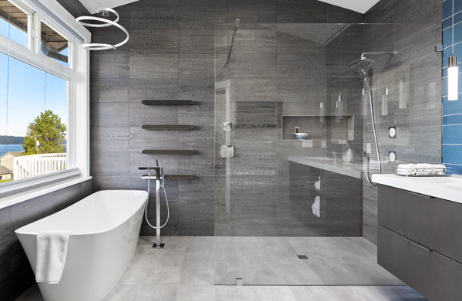
This damp room in Maciltio, Washington, is a remodeled design by Kristine Tyler of Tree Frog Design. “They hired me and said, ‘Our bathrooms are outdated. We wanted a walk-in shower, we wanted a soaking tub, so design it well,” she said. The result is a striking open space with large tiles, hansgrohe light fixtures, eye-catching light fixtures, towel warmers, and even a TV with views of Puget Sound.

This damp room was designed + built by Carnemark in Washington, D.C., with a different approach and no bathtub. It consists of a shower area with a curbless entrance, a ceiling-mounted shower head and a small mosaic floor that distinguishes it from the large size tile tiles of the rest of the space.

The wet room with stepped shower area has a short curb to step over and partially or fully fixed or hinged glass to enclose the shower and bath space. Located in Langley, British Columbia, this small wet room was designed by KS and features a curb-separated bathing area that includes a wall-mounted shower and tub unit, rain showerhead, and freestanding bathtub. The designers used neutral, large-format floor-to-ceiling tiles on the walls and patterned tiles on the floor, which extended to the rest of the bathroom.
A wet room can undoubtedly dramatize a space and become an eye-catching focal point in the home. All the extra wall and floor space allows you to get creative with your tiles. Some homeowners find it easier to clean a damp room, while others lament the number of tiles that need to be wiped. As with any type of renovation, there are pros and cons.

Replacing an outdated bathroom with a wet room can make the space feel more modern, open, and streamlined. Replacing a built-in bathtub with a beautiful freestanding bathtub saves space. Without a shower curtain or a full shower door, the room could be easier to clean. The openness allows the beautiful tiles to be fully displayed in the shower area. It offers amenities such as steam units, water jets, benches, and other spa luxuries.
The wet room is also suitable for smaller spaces without a separate bathtub. Designer Sarah Jefferys renovated the master bathroom of an apartment in New York City and created a small wet room with a built-in bathtub.

“Free-standing, more curved bathtubs don’t work well in limited spaces because it’s hard to get into the corners behind the tub for cleaning,” she says. “We found that this shower combination with the tub worked well with a walk-in shower without having to step into the tub, and there was also a separate deep soaking tub that snuggled snugly into the alcove.”
The beautiful patterned wall tiles behind the tub are Ann Sacks glass segmented hexagonal mosaics with custom finishes, and the other wall tile and tub tile is 4×16″ Bianco Dolomiti marble. The floors are Badilio marble tiles.
The reality is that renovating a bathroom with special waterproofing, floor construction, and additional tiles that extend all the way to the ceiling will increase the cost. Future homebuyers may prefer a traditional bathroom layout, which may affect resale value.
Freestanding bathtubs aren’t for everyone, and they can be difficult to climb in and out. If there is enough space, a swivel mop helps to clean the surroundings of such baths. Larger open spaces require adequate heating, preferably radiant underfloor heating, which can also add to the expense.

Since the damp room is open and the area subject to moisture is larger, the use of waterproof tiles is essential. Porcelain and tiles are more practical than cement and natural stone because they are not porous. The tiles used for the flooring should be non-slip. Smaller mosaics have more grout and produce better grip; When using large-format tiles with less grout, make sure that the tile surface is textured so that it is not easy to slip.
The penny round mosaic floor tiles in this large wet room in Denver were designed by Ashley Campbell Interior Design and feature enough grout to provide plenty of grip that contrasts with the large-format marble-like wall and ceiling tiles.

Even large, humid rooms that don’t have an enclosed shower area will usually have some sort of glass partition to provide some separation. The wet room shown here is a remodeled area of a Dallas home designed by SB Long Interiors, with a fixed glass panel that partially separates the shower area. Located on the same side as the ceiling-mounted rain shower head, it is unobtrusive and offers beautiful views of the grey tiles, sculptural tub and the outdoors.
Replacing a standard bathroom with a damp room is not a typical DIY project. You’ll need to hire a plumber or construction team to do the plumbing remodeling and build a sloping floor that connects with the sewers. The recommended ground slope is 1.5 to 2 degrees, and square or linear sewers can be used. Before laying tiles, it is common to install waterproofing membranes on the walls. There needs to be a waterproof base layer under the floor tiles.
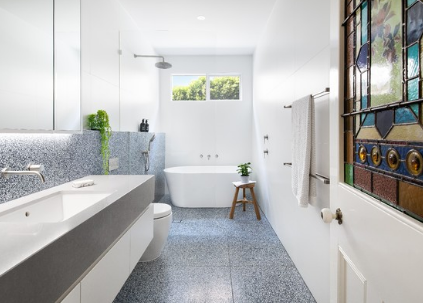
In this stylish, damp room renovated by GIA Bathrooms &; Kithens in Melbourne, Australia, the drain is located underneath the shower head and the floor is appropriately angled. GIA’s Olivia Cirocco said, “A slope is created underneath the freestanding tub so that the water behind the tub falls into the shower wastewater. The 12 x 24-inch white wall tiles contrast with the 24-inch square gray terrazzo floor tiles, which also serve as a backdrop.
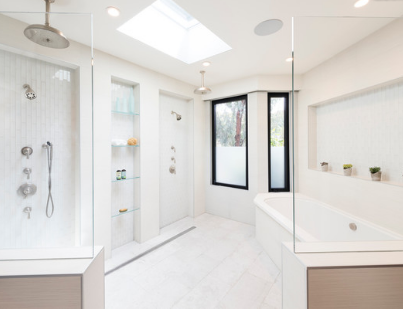
A long horizontal gutter can be seen in this wet room in San Diego, which is part of a new home built by IS Architecture. The spacious space features dual showers, integrated storage and a built-in bathtub. For privacy, skylights and semi-frosted windows bathe the bright white space in natural light.
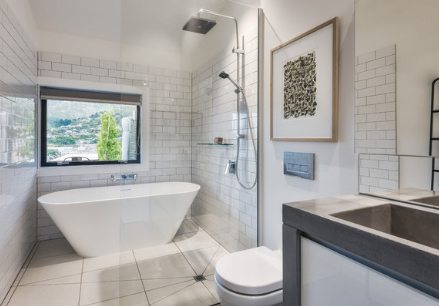
Water flows into the square gutter of this damp room in Christchurch, New Zealand, which was rebuilt by Pynenburg & Collins Architects after the earthquake. Bright subway tiles line the walls, and part of the glass pane separates the bathing area. Jody Seabright, director of the company, said that damp rooms are becoming increasingly popular for those who want to relax in the bathtub.
“You want it to feel spacious, inviting, and not have to worry about how to use it or how long to use it,” he said. “As people tend to re-evaluate their lifestyles and what matters to them, creating private spaces that enrich their daily lives is becoming increasingly important for many.”